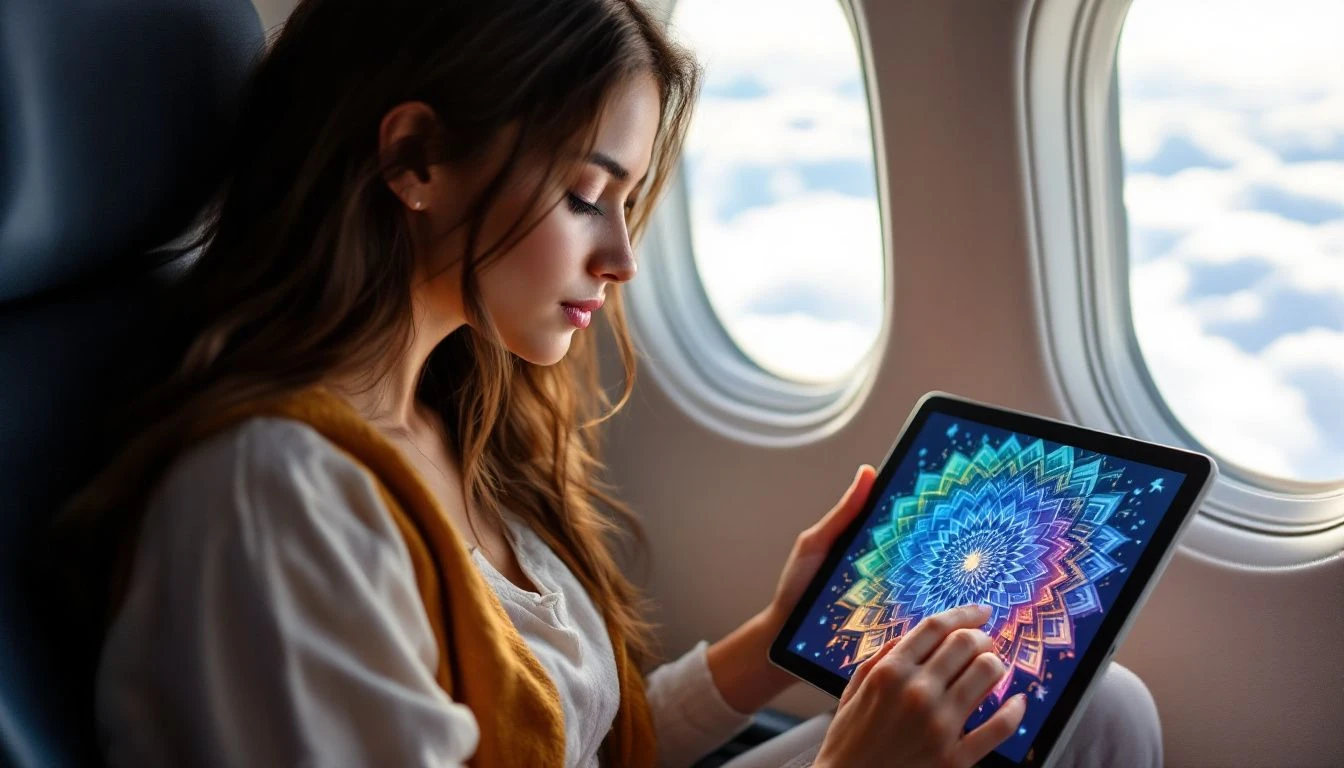How to Get Over Fear of Flying - Ultimate Guide


Top Tips on How to Get Over Fear of Flying
Many people fear flying, but it doesn’t have to hold you back. This guide will show you how to get over fear of flying with practical tips and techniques. Let’s help you fly with confidence.
Key Takeaways
Identify the root causes of your fear of flying, such as past experiences or media influence, to help manage anxiety.
Learn about airplane safety features and turbulence to demystify flying and ease your fears.
Utilize technology and relaxation techniques, like breathing exercises and apps, to distract yourself and stay calm during flights.
Understand the Root Cause of Your Fear
Understanding the origin of your fear is the first step in overcoming it. Personal experiences, like a difficult flight in the past, often contribute to a fear of flying. One frightening flight can make you anticipate anxiety in future flights. This type of anticipatory anxiety can be very powerful, leading to increased overall anxiety about flying.
Media coverage of catastrophic events involving flying can also exacerbate your so much fear. Hearing about plane crashes or other negative events can create vicarious fears, increasing anxiety. Recognize that such incidents are extremely rare and not representative of the general safety of air travel.
Common fears related to flying include claustrophobia, fear of heights, and fear flying. Feelings of claustrophobia and being trapped can significantly heighten anxiety during flights.
Life stressors, whether positive or negative, can contribute to developing a fear of flying. As we age, we may become more aware of life’s fragility, which can lead to heightened fears about flying. Recognizing these root causes helps in managing anxiety and overcoming fear.
Learn About Airplane Safety Features

Understanding how airplanes work can significantly reduce your fear of flying. Airplanes incorporate numerous safety features to handle emergencies. Aircraft are designed to manage engine failures with established procedures and extensive pilot training. How many planes have airplane engines that are frequently checked for safety, and planes can glide up to 100 miles without power?
Safety procedures are in place to ensure pilots manage emergencies effectively. Pilots handle emergencies by first aviate, then navigate, and finally communicate, focusing on immediate safety actions. Airplanes undergo rigorous stress and extreme flight tests before commercial use approval. These procedures can alleviate anxiety and make safe flying more comfortable when a plane flies.
Modern airplanes are equipped with HEPA filters that remove 99.9% of impurities, including bacteria and viruses, from cabin air. Knowing these facts can help you feel more secure and reduce your overall anxiety about flying. The more you know about how airplanes work, the less fearful you’ll be.
Demystify Turbulence
Understanding what causes turbulence can help demystify this common anxiety trigger. Turbulence is a disruption in airflow, often caused by atmospheric conditions. Thermal turbulence arises from uneven ground heating, leading to rising and falling air currents. Mechanical turbulence results from physical barriers like mountains or buildings disrupting airflow.
Weather-related turbulence is mainly caused by storms, creating strong vertical air movements. The jet stream can cause turbulence due to changes in wind speed and direction at cruising altitudes. Pilots often adjust altitude to find smoother air when turbulence is detected. Modern aircraft are designed to flex with turbulent air, enhancing passenger safety and comfort.
Selecting a seat towards the front of the aircraft can reduce anxiety as it experiences less turbulence. Pilots activate the seatbelt sign to ensure passenger safety during anticipated turbulence. Understanding turbulence can help you feel more at ease during a bumpy ride and see it as a normal part of flying.
Use Technology for Reassurance
Technology can be an effective tool in managing anxious feelings related to flying. Flight Radar 24 can track around 200,000 flights daily, showcasing the safety of commercial aviation. Observing other flights can put your own actual flight into perspective, reducing fear.
The ‘Am I Going Down’ app allows users to assess the likelihood of a plane crash based on specific flight information, providing reassurance. The SOAR app offers videos, turbulence information, a G-force meter, and weather forecasts to ease flying anxiety. Using these tools can help you stay within your comfort zone and manage anxiety effectively.
Creating a playlist with calming music or engaging audiobooks can keep your focus off anxiety triggers and boost confidence during the flight. Technology can help you feel more in control and reduce overall anxiety, making it easier to overcome your fear of flying.
Practice Relaxation Techniques

Relaxation techniques are invaluable for managing flight anxiety. Breathing exercises can significantly lower stress levels and calm the mind before flying. Controlled breathing techniques have been practiced for centuries to manage anxiety. One technique is box breathing, which maximizes breath to reduce anxiety.
Mindfulness meditation helps regulate thoughts and emotions during a flight. The Headspace app offers meditation specifically for fear of flying, which can lower anxiety levels. Grounding techniques, which focus on the five senses, can reduce anxious thoughts.
If you experience a panic attack during a flight, counting down from 30 seconds and taking deep breaths can help manage it. These techniques can help you feel in control and reduce overall anxiety, making it easier to manage your fear of flying.
Distract Yourself During the Flight

Keeping occupied during a flight can effectively manage flight anxiety. Reading novels or travel guides can serve as a great distraction on the plane. Mobile games are another excellent way to distract from anxiety triggers. Pre-planning your trip can keep your mind occupied while flying.
Engaging in conversation with fellow passengers can alleviate nervousness. This not only distracts from fears but also creates a sense of connection and support. Keeping busy with different activities can effectively distract from fears and make the journey more enjoyable.
Whether reading, playing games, or chatting with fellow passengers, keeping your mind occupied can significantly reduce flight anxiety and help you fly comfortably during a short flight.
Communicate With Flight Attendants
Flight attendants ensure your safety and comfort, and can be a great support for nervous fliers. Informing the flight crew about your anxiety can lead to personalized support. Travelers with anxiety should notify flight attendants as soon as possible for better support.
Flight attendants can provide reassurance and check on anxious passengers during the flight. Trained to handle various situations, a flight attendant can offer comfort and guidance to help you feel more at ease. Passengers should communicate their specific needs and preferences to the cabin crew.
Communicating with flight attendants ensures you get the support needed to manage flight anxiety and fly more comfortably.
Consider Professional Help
For severe fear of flying, seeking professional help can be crucial. Exposure therapy, which involves gradually facing fear, is a recommended method to confront flying anxiety. Workshops and therapy sessions offer structured support to help individuals face flying anxiety.
Joining a comfort group offers support and understanding for those facing flight anxiety. A doctor may prescribe anti anxiety medication to help alleviate flying anxiety for some individuals. Engaging in physical activity before a flight can reduce excess energy and anxiety.
Consulting with a therapist can uncover past experiences contributing to flight-related anxiety and establish coping strategies. Professional help provides the tools and support needed to manage anxiety and overcome fear of flying.
Visualize Positive Outcomes

Visualization is a powerful tool to overcome fear. Focus on the positive experiences and destinations awaiting you to turn fear into excitement. Imagining daily flights can change your mindset towards flying. Visualizing your trip before departure can reduce fear by mentally walking through the steps of air travel.
Remind yourself of flight safety and tell yourself you enjoy flying. Imagining a successful flight can turn fear into positive feelings. Focusing on positive outcomes and visualizing success can make your fear of flying more manageable.
Choose the Right Seat

Choosing the right seat can minimize fear triggers and help you fly comfortably. A window seat may benefit those concerned about motion, allowing focus on the horizon. An aisle seat can provide a sense of freedom and ease for those feeling claustrophobic.
Extra legroom seats can alleviate discomfort for passengers who feel restricted in smaller spaces. Avoiding window seats can help reduce anxiety if you fear heights.
Selecting a seat that suits your needs creates a more comfortable and less anxiety-inducing flying experience.
Summary
Overcoming the fear of flying is a journey, but with the right strategies and mindset, it’s entirely possible. Understanding the root cause of your fear, learning about airplane safety features, and demystifying turbulence are crucial steps in managing your anxiety. Using technology for reassurance, practicing relaxation techniques, and distracting yourself during the flight can also help reduce anxiety.
Communicating with flight attendants and considering professional help are important strategies for severe cases of flight anxiety. Visualizing positive outcomes and choosing the right seat can further enhance your comfort and confidence when flying.
Remember, millions of people overcome their fear of flying every day. With persistence and the right approach, you can join them and enjoy the freedom and excitement that air travel brings.
Frequently Asked Questions
What are some common causes of fear of flying?
Fear of flying often arises from past traumatic flights, anxiety about heights or enclosed spaces, and heightened awareness of media coverage on aviation disasters. Understanding these triggers can help manage the fear.
How can learning about airplane safety features help reduce anxiety?
Learning about airplane safety features can significantly reduce anxiety by reassuring you of the extensive testing and procedures in place to ensure your safety. Knowing how modern technology works, like HEPA filters, can make flying feel much safer.
What techniques can help manage anxiety during a flight?
Breathing exercises, mindfulness meditation, and grounding techniques can really help manage anxiety during a flight. Give them a try to feel more at ease in the air!
How can communicating with flight attendants help reduce flight anxiety?
Talking to flight attendants about your anxiety can really help; they can offer you reassurance and check in on you during the flight. Just knowing someone is aware of your feelings can make the experience a lot easier.
When should I consider seeking professional help for my fear of flying?
If your fear of flying is affecting your ability to travel or causing significant distress, it's a good idea to seek professional help. Therapies and workshops can offer you the support and strategies you need to cope with your anxiety.